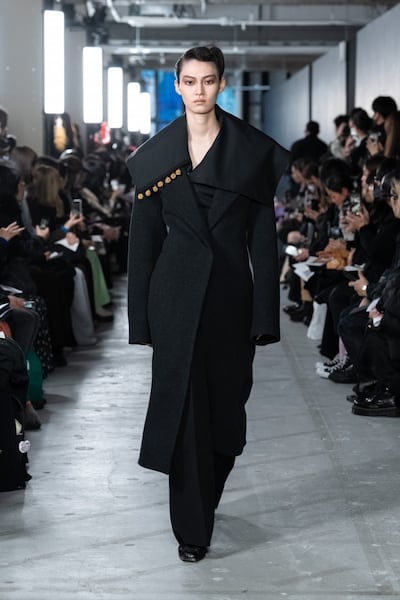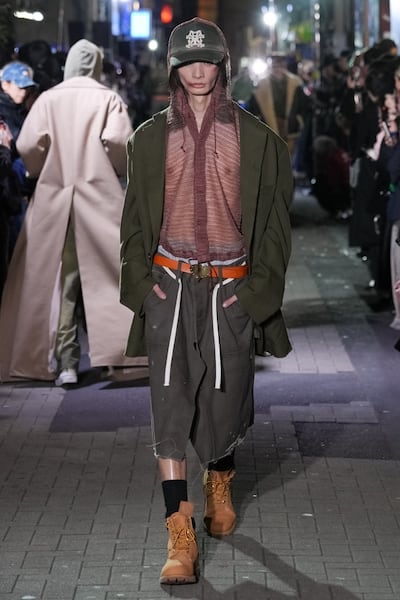
Emotions were running high at last month’s Viviano show in Tokyo.
Designer Viviano Sue sent models down the runway in dark yet romantic looks replete with head-to-toe lace, theatrical tiered ruffles, and structural quilting in porcelain palettes — nods to the interiors of his childhood in Shanghai. After the finale, which saw models pose on the former imperial residence’s grand staircase at the Meiji-era Kihinkan Guest House, team members and attendees broke into tears.
“I’m so happy they were touched by our story…we felt a lot of love from the crowd. Our Instagram exploded with mentions,” said Sue, a graduate of Bunka Fashion College, during the latest edition of Tokyo Fashion Week. The event has officially been called Rakuten Fashion Week Tokyo since the Japanese e-commerce giant became title sponsor in 2019.
Having won last year’s Tokyo Fashion Award, a prize sponsored by the city’s metropolitan government and the Japan Fashion Week Organization that funds a Paris Fashion Week showroom stint for eight Tokyo-based brands, Sue has reached a pivotal point in the brand’s business trajectory.
“Our show looks very conceptual, but our collections have a lot of commercial pieces to sell now,” said Sue, who rebooted the brand in 2020 under its current name after founding its forerunner in 2015.
Stocked by 30 domestic retailers from Beams and United Arrows to department stores Isetan and Marunouchi, the designer is now gearing up to cast his net wider — namely by working with stockists in Shanghai and Seoul — before returning to Paris. He is also set to launch a menswear collection later this year.
Sue’s global ambitions are emblematic of a new wave of Japanese designers. Small fashion businesses are increasingly aware that relying on Japanese shoppers alone is untenable amid recent macroeconomic headwinds, including softer consumer demand as living costs rise and the yen recently hitting a 34-year low against the dollar.
The Japan-Paris route is one many ambitious designers have made before. After Hanae Mori’s international breakthrough in the 1960s, designers like Kenzo Takada, Kansai Yamamoto and Issey Miyake made waves in the 1970s; Rei Kawakubo’s Comme des Garçons and Yohji Yamamoto wowed the industry in the 1980s.
Following Junya Watanabe’s Paris debut in the 1990s, the European fashion capital was introduced to the likes of Jun Takahashi’s Undercover, Tsumori Chisato, Chitose Abe’s Sacai and Maison Mihara Yasuhiro in the following decades, and more recently names like Mame Kurogouchi, Kunihiko Morinaga’s Anrealage and Ryota Iwai’s Auralee. A few have been thrust into the international spotlight through the LVMH Prize which helped launch the careers of Doublet’s Masayuki Ino and Tomo Koizumi.
But the Japanese designer talent pool is nothing if not polarised. In contrast to those who made a name for themselves overseas, there are others with international potential who remain in Tokyo. Some are surprisingly insular, seemingly satisfied with keeping their business domestic, while others are either unable or unwilling to make the changes and investments needed to start trading internationally.
But change is afoot for many in the latter camp who have shifted their perspective in recent years, suggests Auralee’s Iwai. “There’s been a growth in younger brands trying to expand outside Japan, which wasn’t so much the case before. There’s the financial and business scale reason behind it, but there’s also been a shift in generation and culture,” he said.
According to Daigo Takeuchi, who oversees operations at Misa Takeuchi’s Photocopieu, one of this year’s Tokyo Fashion Award winners, another factor at play is the way the Japanese wholesale market operates. “Buyers [here] really focus on price but, internationally, they see more of the whole picture [so] we can make ourselves more understood [there],” he said.
“It’s a bigger pool, so some don’t like it, but some love it.”
Spheres of Influence
Either way, a more outward-looking perspective is something that Tokyo Fashion Week is encouraging through its many international initiatives.
The event has received an influx of interest from companies and parties looking to sponsor the event’s overseas activities, said Kaoru Imajo, director of the Japan Fashion Week Organization, which runs fashion week.
Domestically, Imajo’s team is also working on off-schedule shows in partnership with the Tokyo metropolitan government, which they are hosting on the city’s streets to ramp up public awareness. “This will be a kind of experiment for us — we need to merge these things with fashion week so we can get more attention,” he explained.
Japanese brands’ desires for a broader reach are matched by both global interest in them and the country’s reputation as a breeding ground for new talent. In the 10 years that Los Angeles-based consultant and street-style favourite Nick Wooster has attended shows in the capital, he has seen several brands “graduate” and head to Paris.
“It’s consistently an incubator,” said Wooster, referring to Tokyo Fashion Week. “You see both sides: what’s happening on the trade end, and how it translates within the rich retail landscape, [and Tokyo] being one of the most exciting shopping cities in the world.”
Major international retailers like Lane Crawford are seeing greater demand for Japanese brands, particularly under-the-radar labels, said Joyce Chung, menswear tailoring buyer at the Hong Kong-based luxury department store group with branches across China, who attended Tokyo Fashion Week shows for the first time this season.
“This season, we’re sourcing niche designers that few people recognise. We’re aiming for something exclusive, the best of the best from Japan,” she said.
Names to Know
Chung’s standout show was Harunobu Murata, whose considered accessories and silhouettes in pared-back hues echoed Jil Sander and The Row. “The designers I’m seeing are becoming more sophisticated. They have their own details and tap into high-quality techniques and made-in-Japan features,” she added.

Menswear tastemaker Motofumi “Poggy” Kogi pointed to Kiichiro Asakawa’s material-minded minimalist label Stein (which eight years in, is nurturing a network of international stockists) as a business poised to succeed overseas in the wake of the quiet success of Auralee. He also lists Shinpei Goto’s Masu, which showed in Paris this year as the beneficiary of the Tokyo Fashion Award, as worth watching thanks to its robust production network that will come in handy as it enters new markets.
Unlike previous editions, the Autumn/Winter 2024 season of fashion week didn’t see the homecoming of an established Japanese brand like Sacai or Undercover, which Wooster calls this edition’s “missing link.” Nonetheless, he saw promise in Koki Abe’s five-year-old craft-centric collective Khoki, which is drawing attention as both a LVMH Award finalist and 2023 Tokyo Fashion Award winner.
For Maiko Shibata, creative director and head buyer at Japanese multi-brand boutique Restir, the Tokyo brands to watch speak their own unique languages — a trait she compares to Chitose Abe’s signature hybridity at Sacai. In her eyes, menswear is a highlight, with Khoki, streetwear and vintage-inspired Kamiya, which relaunched last year under the direction of Koji Kamiya, and nine-year-old Soshi Otsuki, which fuses tailoring with traditional Japanese garments and textiles, leading the charge.
“They have a deep knowledge of vintage and great ideas [on ways to] reinterpret subculture,” says Shibata. “They mix those elements with care and good quality, which is quite rare outside of Japan.”
Growing Pains
Despite recent moves to bridge the gap between Tokyo’s up-and-coming designers and overseas industry retailers and partners, there is still a long way to go as made clear by the palpable shortage of global buyers on the front rows of fashion week. And it’s not just down to the fact that most buyers’ budgets are depleted by the time Tokyo kicks off after Paris.
One perennial challenge is that Japan’s system leaves brands free to choose their own dates for showrooms and sales appointments.

“If you’re a buyer from Paris or New York and you need to choose the time period to have a trip [to Tokyo], which dates do you make the journey?” stated Wooster, noting that by contrast, “in Paris the market week is the market week… everyone understands exactly when the dates are.”
The lack of a centralised, consolidated market week also poses challenges for Japanese brands looking to break into foreign markets. Their biggest hurdle, suggests Wooster, is to make sense of the cadence of the global calendar in the context of the local one.
Other barriers to internationalisation include Japanese brands’ pricing strategies and their tendency to hyper-localise products in terms of sizing and draw inspiration from niche subcultures, notes Shibata. “These brands will find it hard to go global, I think.”
Even though today’s generation faces a far more crowded international market than previous generations, global industry insiders continue to look to Tokyo for a hint of what’s next. With questions of who can follow in the footsteps of masters like Yohji Yamamoto and Comme des Garçons on many lips, some insiders are optimistic that a strong contender is on the horizon.
“Some are getting stronger, but they need time,” said Cerada Biffi, head buyer at Milan’s Gruppo Biffi Boutiques, early stockists for brands like Comme des Garçons, Yohji Yamamoto, Kenzo and Sacai over the years. “Comme and Yohji weren’t successful straight away. The new designers, they need to be sure of themselves.”


